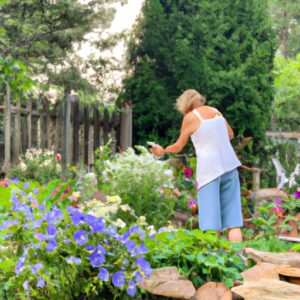Gardening has emerged as more than just a hobby; it has become a popular way to engage with nature while nurturing beautiful plants. But have you ever wondered if gardening can also count as exercise? In this article, we will explore the physical and mental benefits of gardening and answer the question, “is gardening exercise?”
Introduction
As the world becomes more health-conscious, people are seeking ways to incorporate exercise into their daily routines. At the same time, gardening has seen a tremendous rise in popularity. It offers an opportunity to connect with nature, create stunning landscapes, and grow your own fresh produce. But does it really provide the physical benefits of exercise?
The Importance of Exercise for Health and Well-being
Before we dive into the world of gardening, let’s first acknowledge the significance of exercise in maintaining a healthy lifestyle. Regular physical activity is known to improve cardiovascular health, boost immune function, and enhance mental well-being. Engaging in exercise helps us stay fit, manage weight, and reduce the risk of chronic diseases. But can gardening contribute to these benefits?
Unveiling the Physical Demands of Gardening
Gardening entails a myriad of physical activities, such as digging, planting, weeding, and watering. These tasks require various muscle groups to work harmoniously, leading to increased physical exertion. While it may not be as intense as a high-intensity workout, gardening can still get your heart rate up and burn calories.
Stay tuned for the next section, where we will delve deeper into the physical benefits of gardening. Discover how gardening can contribute to cardiovascular health, aid in weight management, and improve your overall physical fitness. So, is gardening exercise? Let’s explore together!
The Physical Demands of Gardening
Engaging in a Full-Body Workout
When you think of exercise, you might imagine hitting the gym or going for a run. But did you know that gardening can also provide a full-body workout? The physical activities involved in gardening, such as digging, planting, weeding, and watering, require you to move and engage various muscle groups.
Digging and Planting: Building Strength and Endurance
Digging and planting involve using your upper body and core muscles to lift and maneuver soil, plants, and gardening tools. These activities help build strength and endurance, working your arms, shoulders, back, and abdominal muscles. The repetitive nature of digging and planting can also improve muscle tone and flexibility over time.
Weeding: Enhancing Flexibility and Balance
Weeding requires bending, kneeling, and reaching, which can enhance your flexibility and balance. These movements engage your leg muscles, including your quadriceps, hamstrings, and calves. Additionally, the act of pulling out weeds from the ground activates your core muscles, contributing to better stability.
Watering: Improving Cardiovascular Health
Believe it or not, even watering your plants can contribute to your cardiovascular health. Moving around the garden with a watering can or hose increases your heart rate, promoting blood circulation and boosting your overall cardiovascular fitness. It may not be as intense as running on a treadmill, but it still gets your blood pumping.
Calorie Burn: A Surprising Benefit of Gardening
While gardening may not be as rigorous as a high-intensity workout, it can still help you burn calories. The physical exertion involved in gardening tasks can lead to a significant calorie burn. For instance, an hour of moderate-intensity gardening can burn approximately 300-400 calories, depending on your body weight and the intensity of your gardening activities.
Stay tuned for the next section, where we will uncover the numerous benefits of gardening as exercise. Discover how gardening can improve your cardiovascular health, contribute to weight management, and enhance your overall physical fitness. So, is gardening exercise? Let’s dig deeper!
Benefits of Gardening as Exercise
Cardiovascular Health and Improved Heart Health
Gardening is not only a feast for the eyes but also a treat for your heart. Engaging in this activity gets your blood pumping and promotes cardiovascular health. The physical demands of gardening, such as digging and planting, increase your heart rate, improving blood circulation throughout your body. This, in turn, strengthens your heart and reduces the risk of cardiovascular diseases.
Weight Management and Healthy BMI
Maintaining a healthy weight is crucial for overall well-being. The good news is that gardening can help you manage your weight and achieve a healthy Body Mass Index (BMI). Activities like weeding and watering require physical effort and burn calories. By incorporating gardening into your routine, you can create a calorie deficit, which can contribute to weight loss or weight maintenance.
Flexibility, Strength, and Overall Physical Fitness
Gardening involves a wide range of movements that promote flexibility and strength. Bending, squatting, and reaching while gardening improve joint mobility and increase muscle flexibility. Additionally, activities like lifting pots or bags of soil can help build strength in your arms, shoulders, and back.
Moreover, the overall physical demands of gardening contribute to improving your fitness level. Regular gardening can enhance your endurance, stamina, and overall physical performance. It is a wonderful way to stay active and engage various muscle groups, resulting in improved overall physical fitness.
In the next section, we will explore the positive impact of gardening on mental health. Discover how this activity can reduce stress, boost your mood, and provide a therapeutic escape from daily life. So, keep reading to uncover the incredible mental health benefits of gardening!
Mental Health Benefits of Gardening
Stress Reduction and Improved Mood
Gardening goes beyond physical exercise; it has remarkable psychological benefits as well. One of the significant advantages of gardening is its ability to reduce stress and uplift your mood. Spending time in the garden allows you to escape the pressures of daily life and immerse yourself in a serene and natural environment.
Studies have shown that gardening can lower cortisol levels, the hormone associated with stress. Digging in the soil, tending to plants, and watching them flourish can be incredibly therapeutic. The act of gardening stimulates the release of endorphins, the feel-good chemicals in our brain, which can alleviate anxiety and improve overall mental well-being.
Mindfulness and Relaxation
In our fast-paced world, finding moments of tranquility can be challenging. Gardening provides a unique opportunity to practice mindfulness and embrace the present moment. As you engage with the soil, plants, and the sounds of nature, you can let go of distractions and focus on the task at hand.
The rhythmic movements involved in gardening, such as planting or pruning, can induce a state of relaxation. The repetitive nature of these activities allows your mind to enter a calm and meditative state. This mindfulness not only reduces stress but also enhances your ability to concentrate and find inner peace.
Gardening as a Therapeutic Activity
Beyond its immediate mental health benefits, gardening has increasingly been recognized as a therapeutic activity. Horticultural therapy, a practice that utilizes gardening to promote well-being, has shown promising results in various populations. It has been found to aid individuals dealing with depression, anxiety, and even post-traumatic stress disorder.
Gardening provides a sense of purpose, accomplishment, and connection to the natural world. It allows individuals to nurture and care for living organisms, fostering a sense of responsibility and self-worth. Whether you have a small balcony garden or an expansive backyard, gardening can be a source of solace and healing.
Stay tuned for the next section, where we will uncover valuable tips on turning gardening into an effective workout. Discover how to maximize the exercise benefits of gardening and integrate it seamlessly into your fitness routine. Gardening truly is a holistic activity that nurtures both the body and mind.
Tips for Turning Gardening into an Effective Workout
Gardening can be more than just a leisurely activity; it can be a fantastic opportunity to get a workout while tending to your plants. Here are some tips to maximize the exercise benefits of gardening and transform it into an effective workout:
1. Proper Gardening Tools and Techniques
Using the right tools and techniques can make a significant difference in the physical demands of gardening. Invest in ergonomic gardening tools that are designed to reduce strain on your joints and muscles. This will help you maintain proper posture and minimize the risk of injuries. Additionally, learning proper gardening techniques, such as bending from the knees instead of the waist, can help engage your muscles effectively.
2. Warm Up and Stretch
Just like any other exercise routine, it’s essential to warm up before diving into gardening. Take a brisk walk or perform some light stretching exercises to prepare your muscles and joints for the physical activity ahead. After your gardening session, don’t forget to cool down and stretch again to prevent muscle soreness and promote flexibility.
3. Incorporate Gardening Exercises
To further enhance the workout aspect of gardening, consider incorporating specific exercises or movements. For example, while weeding, squat down instead of kneeling to engage your leg muscles. Lift bags of soil or pots using proper lifting techniques to work on your upper body strength. You can even turn watering into a mini cardio session by using a heavy watering can and briskly moving between plants.
Remember, the key is to listen to your body and gradually increase the intensity of your gardening workouts. Start with shorter sessions and gradually extend the duration as your fitness level improves. By implementing these tips, you can transform your gardening routine into an effective workout that benefits both your physical health and your garden’s vitality.
Stay tuned for the concluding section, where we will summarize the main points discussed and emphasize the benefits of gardening as exercise.
Conclusion
After exploring the physical demands and benefits of gardening, it is clear that gardening can indeed be considered a form of exercise. Engaging in gardening activities like digging, planting, and weeding requires physical effort and can contribute to cardiovascular health, weight management, and overall physical fitness.
Not only does gardening offer physical benefits, but it also has a profound impact on mental well-being. The act of tending to plants and being in nature can reduce stress, improve mood, and promote relaxation. Gardening provides a therapeutic escape from the fast-paced modern world, allowing you to find solace and peace amidst the beauty of nature.
So, the next time you’re in your garden, take a moment to appreciate the physical and mental benefits it offers. Embrace gardening as a way to stay active, improve your fitness, and cultivate a sense of tranquility. Whether you have a small balcony garden or a spacious backyard, gardening can provide you with a fulfilling and rewarding experience.
In conclusion, gardening is not just a hobby – it is an exercise that nourishes both your body and soul. So grab your gardening tools, put on your gardening gloves, and let the wonders of gardening unfold. Get ready to reap the physical and mental rewards that gardening has to offer. Happy gardening!
Remember, gardening may not replace a structured exercise routine, so it’s essential to incorporate other forms of exercise to achieve a well-rounded fitness regimen.
Stay tuned for more insightful articles on gardening, fitness, and wellness.





